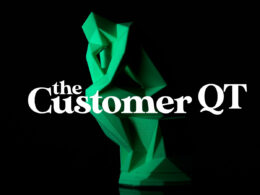Most customer service experiences used to be personal. The person behind the counter was familiar, friendly; with personal exchanges that built real connections. Today, most of our connections are now digital (automated & impersonal). Our metaphorical counters are usually wide, perhaps even a continent away.
In our pursuit of faster, more immediate service, we’ve lost the human touch. According to a recent Forrester Research report entitled “The Missing Human Connection,” that sacrifice could mean the difference between success and failure Emotion, says the report, “continues to be the most potent driver for growth.” It indicates that a lack of emotion could be a detriment to customer loyalty, driving real and significant financial risk for companies that don’t make human connection a priority.
Where are we to go from here? Digital purchasing isn’t going anywhere. International sales can only grow. And the demand for self-service is only anticipated to rise.
How can we balance the human with technology and bring the empathy back to service?
AI and machine learning are poised to revolutionize nearly every single industry on the planet, and in many sectors, that revolution has already begun. Indeed, when it comes to customer service, the era of the chatbot has been in full swing for years. To many, however, it is precisely that reliance on chatbots that has accelerated the loss of empathy in the industry.
That’s because until recently those chatbots, widespread as they are, have been defined by two words: generic and flawed. Imagine a customer service representative who could not remember a customer no matter how often she visited, could not recognize when a customer was upset, could not speak a customer’s language, and so on.
But that doesn’t have to be true. Fortunately, while the era of bad chatbots once dominated, the era of good chatbots has just begun.
Automating the Personal Touch
The biggest issue with typical chatbots is a lack of personalization. When you speak with a human customer service agent, she can adapt to the direction of the conversation. A good customer service agent doesn’t just read from a script but will offer different experiences for different customers depending on their individual needs.
It has historically been very difficult for chatbots to do the same, because doing so relies heavily on the people implementing the bot, and those people are generally software experts, not brand experts. In fact, according to a Forrester survey sponsored by Ada, 50 percent of customer experience leaders claim their teams don’t have the right tools to personalize customer service chatbot experiences.
However, as customer expectations have evolved, so too have the capabilities of chatbot platforms. Now, the right chatbot should empower businesses to provide a personalized experience that engages customers with proactive and reactive content tailored to their interests, information, and intent. Automation provides a scalable way to demonstrate care by creating moments that make customers feel valued and known.
The Forrester survey found that 55 percent of CX leaders believe personalizing automation leads to more satisfied customers, 55 percent believe it means more engaged customers, and 51 percent believe it makes for more loyal customers.
Traditionally, customer service chatbots were reserved for highly technical teams and developers to build, manage, and update. This meant that if something went wrong with a chatbot or if its performance needed to be tweaked, it required a developer and long timelines to make changes. This wasn’t just time-consuming; it would also lead to fewer updates or teams waiting for several different changes to be made at once in batches, inherently making for poor-quality bots.
In addition, the actual automated experience produced poor results. Without an understanding of the customer experience, IT teams create impersonal content that often doesn’t reflect the voice of the brand or the company’s care for the customer.
If organizations want to bring human emotion to AI-powered conversations, they must remove the chatbot from the hands of their IT teams and put it into the hands of customer service professionals who know the business best. To bring authenticity to automated conversations, businesses need to seek out a non-technical chatbot platform that empowers their non-technical support teams to build and manage chatbots rooted in empathy and expertise.
In fact, some organizations have gone as far as building completely new automated customer experience (ACX) teams, dedicated to owning chatbot success. Without the need for highly technical skills or code, these teams are already driving both time and cost savings, while ensuring the chatbot experience is rooted in empathy.
Working Hand-in-Hand
Once, it was thought that if a chatbot was providing value to a company’s bottom line, it was doing its job. Instead, a chatbot should provide value to everyone: the business, the customer, and the agent.
A truly empathy-driven solution exists not to replace human agents, but to empower them by removing the busy work that keeps them from connecting with their customers and giving them purpose. Moreso, the right chatbot platform should provide agents with the right information, like customer background and inquiry details, before they even speak with the customer. This saves time and frustration for both parties, creating new opportunities for more personal conversations.
Happier agents lead to happier customers, which drives higher customer satisfaction scores and increased loyalty. In fact, according to Gartner, 64 percent of customers believe a good customer experience is more important than price when deciding to make a purchase with a company.
Mike Murchison, one of Forbes’ “Top 30 under 30,” is CEO and co-founder of Ada, providers of an artificial intelligence-powered chatbot platform.
This article originally appeared in Smart Customer Service. Photo by Kevin Grieve on Unsplash.










